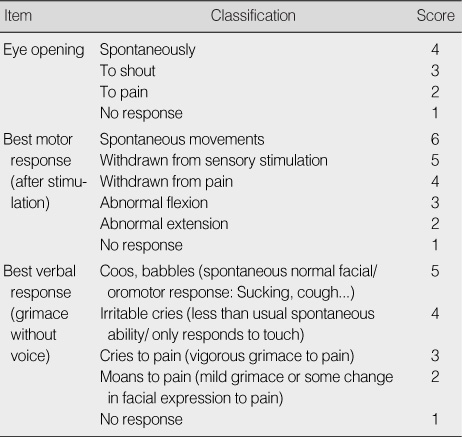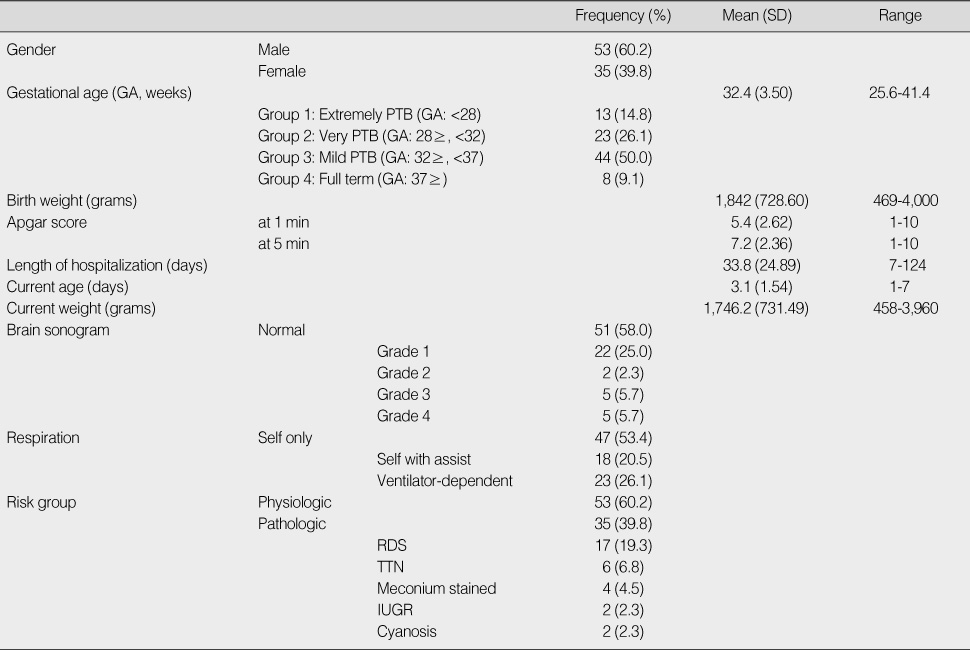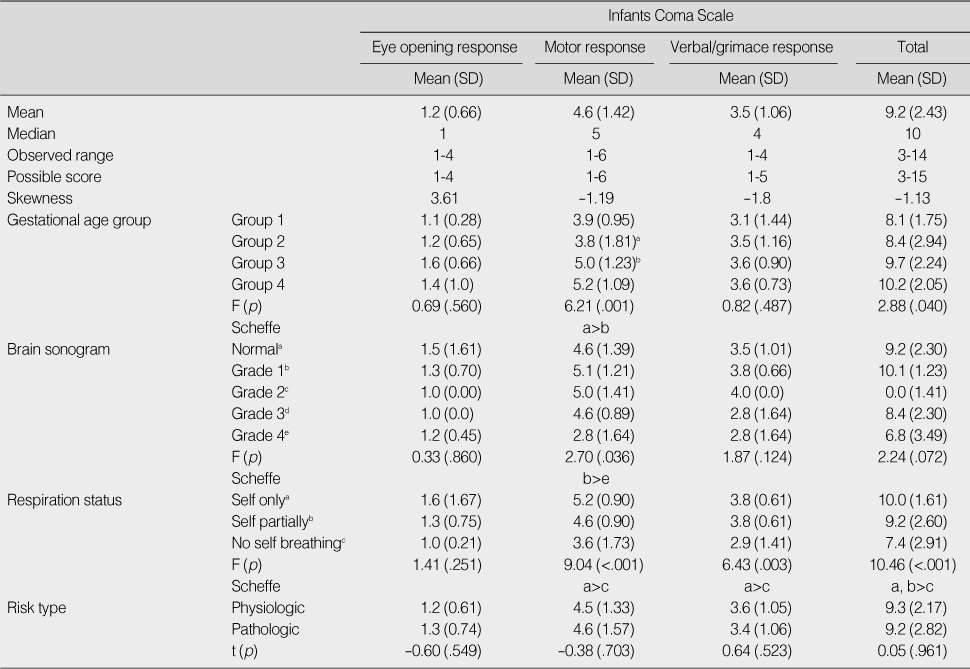Articles
- Page Path
- HOME > J Korean Acad Nurs > Volume 40(4); 2010 > Article
-
Original Article
- Evaluation of Mental Status in High-Risk Neonates using Infants Coma Scale
- Young-Mee Ahn, Min Sohn, Sang-Mi Lee
-
Journal of Korean Academy of Nursing 2010;40(4):561-570.
DOI: https://doi.org/10.4040/jkan.2010.40.4.561
Published online: August 31, 2010
1Professor, Department of Nursing, Inha University, Incheon, Korea.
2Assistant Professor, Department of Nursing, Inha University, Incheon, Korea.
3Doctoral Student, Department of Nursing, Inha University, Incheon, Korea.
- Address reprint requests to: Sohn, Min. Department of Nursing, Inha University, 253 Yonghyeon-dong, Nam-gu, Incheon 402-751, Korea. Tel: 82-32-860-8212, Fax: 82-32-874-5880, sohnmin@inha.ac.kr
Copyright © 2010 Korean Society of Nursing Science
- 657 Views
- 1 Download
Abstract
-
Purpose
- This was a cross sectional descriptive study to introduce the Infants Coma Scale (ICS), describe mental status of high risk infants using ICS and explore the relationships between ICS and clinical variables in infants hospitalized in a neonatal intensive care unit of a university hospital in Korea.
-
Methods
- After ICS was developed and tested by the authors, a research nurse evaluated the mental status of the infants using the English version of ICS and obtained clinical information on the infants from their medical records.
-
Results
- Data from 88 infants were analyzed. About 60% were male, 90% were preterm births, and 40% had pathologic abnormalities. Their mean gestational age was 32.4 (±3.50) weeks and the mean birth weight was 1,842 (±728.6) grams. The Cronbach's alpha for the ICS was .78. There was a statistically significant positive correlation between ICS total score and five clinical variables including gestational age, birth weight, 1 and 5 min Apgar scores and respiration status.
-
Conclusion
- Mental status is an important parameter in nursing assessment. ICS is a valid and reliable instrument, which clinicians can easily use to evaluate the mental status of high risk infants.
- 1. Ahn Y. The relationship between behavioral states and pain responses to various NICU procedures in premature infants. Journal of Tropical Pediatrics. 2006;52:201–205.ArticlePubMed
- 2. Ahn Y, Garruto RM. Weight variation by sex and nature of risk factors in high-risk infants: An evolutionary perspective. Collegium Antropologicum. 2007;31:937–941.PubMed
- 3. Ahn Y, Kang H, Shin E. Pain assessment using CRIES, FLACC and PIPP in high-risk infants. Journal of Korean Academy of Nursing. 2005;35:1401–1409.ArticlePubMedPDF
- 4. Als H. Neurobehavioral organization of the newborn: Opportunity for assessment and intervention. NIDA Research Monography. 1991;114:106–116.
- 5. Anand KJ. Consensus statement for the prevention and management of pain in the newborn. Archives Pediatrics & Adolescent Medicine. 2001;155:173–180.Article
- 6. Behrman RE, Kliegman RM. Nelson essentials of pediatrics. 2002;Philadelphia, Saunders.
- 7. Burns N, Grove SK. Understanding nursing research. Building an evidence-based practice. 2007;Philadelphia, PA, Saunders.
- 8. Curley MA, Harris SK, Fraser KA, Johnson RA, Arnold JH. State behavioral scale: A sedation assessment instrument for infants and young children supported on mechanical ventilation. Pediatric Critical Care Medicine. 2006;7:107–114.ArticlePubMedPMC
- 9. Euser AM, de Wit CC, Finken MJ, Rijken M, Wit JM. Growth of preterm born children. Hormone Research. 2008;70:319–328.ArticlePubMedPDF
- 10. Grunau RE, Holsti L, Peters JW. Long-term consequences of pain in human neonates. Seminars in Fetal & Neonatal Medicine. 2006;11:268–275.Article
- 11. Hahn YS, Chyung C, Barthel MJ, Bailes J, Flannery AM, McLone DG. Head injuries in children under 36 months of age. Demography and outcome. Child's Nervous System. 1988;4:34–40.
- 12. Holmes JF, Palchak MJ, MacFarlane T, Kuppermann N. Performance of the pediatric Glasgow Coma Scale in children with blunt head trauma. Academic Emergency Medicine. 2005;12:814–819.ArticlePubMed
- 13. Jee JI, Choi JO, Cho EY, Lee MS, Lee HS, Lee OK, et al. Neurosonographic findings and neurodevelopmental outcome in infants of less than 1500 gm. Journal of Korean Society of Ultrasound in Medicine. 1994;13:42–46.
- 14. Joung KH, Yoo IY, Kim HS, Kim S, Lee JH. Effects of non-nutritive sucking on the physiological and behavioral states of pre-term infants during tube feeding. Journal of Korean Academy of Nursing. 2006;36:732–741.ArticlePubMedPDF
- 15. Kim HH. Bilirubin variation by oxygen supply in newborns at birth. 2010;Incheon, Inha University. Unpublished master's thesis.
- 16. Korea national statistics. Korean Statistical Information Service. 2010;Retrieved January 15, 2010. from http://www.kosis.kr.
- 17. Lee JA, Kang JS, Cho YH, Hong KS, Kwon OM, Jung MS. Effects of nonnutritive sucking on behavioral state and physiological response of premature infants receiving heel stick. Journal of Korean Clinical Nursing Research. 2001;7:123–140.
- 18. Merenstein GB, Gardner SL. Handbook of neonatal intensive care. 1998;New York, NY, Mosby.
- 19. Nayana PP, Nalini P, Serane TV. Role of Glasgow Coma Scale in pediatric nontraumatic coma. Indian Pediatrics. 2003;40:620–625.
- 20. Odd DE, Lewis G, Whitelaw A, Gunnell D. Resuscitation at birth and cognition at 8 years of age: A cohort study. Lancet. 2009;373:1615–1622.ArticlePubMedPMC
- 21. Park JH, Park HR. Effects of nonnutritive sucking on heart rate, oxygen saturation and behavioral state in premature infants. Journal of Korean Academy of Child Health Nursing. 2007;13:299–307.
- 22. Prasad MR, Ewing-Cobbs L, Swank PR, Kramer L. Predictors of outcome following traumatic brain injury in young children. Pediatric Neurosurgery. 2002;36(2):64–74.ArticlePubMedPDF
- 23. Simpson DA, Cockington RA, Hanieh A, Raftos J, Reilly PL. Head injuries in infants and young children: The value of the Paediatric Coma Scale. Review of literature and report on a study. Child's Nervous System. 1991;7:183–190.
- 24. Szekeres-Bartho J. Immunological relationship between the mother and the fetus. International Reviews of Immunology. 2002;21:471–495.ArticlePubMed
- 25. Tatman A, Warren A, Williams A, Powell JE, Whitehouse W. Development of a modified Paediatric Coma Scale in intensive care clinical practice. Archives of Disease in Childhood. 1997;77:519–521.ArticlePubMedPMC
- 26. Teasdale G, Jennett B. Assessment of coma and impaired consciousness. A practical scale. Lancet. 1974;2:81–84.PubMed
- 27. Walden M, Carrier C. The ten commandments of pain assessment and management in preterm neonates. Critical Care Nursing Clinics of North America. 2009;21:235–252.ArticlePubMed
- 28. White RD. Recommended standards for the newborn ICU. Journal of Perinatology. 2007;27:Suppl 2. S4–S19.ArticlePDF
- 29. Yeom MK. The effects of maternal heart sound on the body weight, physiological reactions and behavioral state of preterm infants. 2009;Incheon, Inha University. Unpublished master's thesis.
- 30. Zeitlin J, Saurel-Cubizolles MJ, De Mouzon J, Rivera L, Ancel PY, Blondel B, et al. Fetal sex and preterm birth: Are males at greater risk? Human Reproduction. 2002;17:2762–2768.ArticlePubMed
REFERENCES
Figure & Data
REFERENCES
Citations

Infants Coma Scale (ICS)
Clinical Variables of the Study Participants, (N=88)
PTB=Preterm birth; RDS=Respiratory distress syndrome; TTN=Transient tachypnea of the newborn; IUGR=Intrauterine growth retardation.
Correlations between Infants Coma Scale and Clinical Variables
Mental Status in High Risk Infants Assessed with Infants Coma Scale
PTB=Preterm birth; RDS=Respiratory distress syndrome; TTN=Transient tachypnea of the newborn; IUGR=Intrauterine growth retardation.
 KSNS
KSNS
 E-SUBMISSION
E-SUBMISSION




 Cite
Cite

